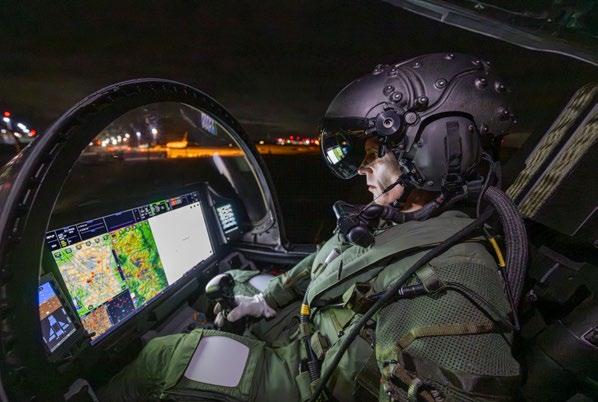
3 minute read
Delivering innovation in 2023
Peregrine ‘eye in the sky’
Under a £20 million contract, DE&S sourced powerful new surveillance sensors from Thales UK, which will be fitted to the S-100 uncrewed air system (UAS) provided by Austrian-based Schiebel. This will give the Royal Navy new uncrewed aerial ‘eye in the sky’ technology to find and track surface contacts of interest, enabling freedom of navigation and good order at sea by, for example, countering piracy and smuggling. From 2024, this new UAS, known as Peregrine, will enable round-the-clock surveillance, feeding real-time images and radar data to Royal Navy warships on the front-line.
Gladiator training suite
A cutting-edge suite of synthetic training devices, which allow personnel from the British Army, Royal Navy and RAF to train together safely and securely, was officially opened in February. Based at the Air Battlespace Training Centre at RAF Waddington, the scale, complexity and security of the training provided by Boeing’s Gladiator system is unmatched across Europe. Key air, land, maritime, space and cyber capabilities will be integrated in the coming years, alongside increased connectivity with allies and partners.
Smart Shooter weapon sight
In June, British Army’s close combat soldiers learnt that, under a new five-year framework agreement worth up to £20 million, they are set to receive a cutting-edge weapon sight that will give them a tactical advantage when countering uncrewed aerial vehicles (UAVs). The Smart Shooter SMASH Smart Weapon Sight Fire Control System can recognise a target, track its movements and maintain a target-lock even if it or the user moves. This greatly increases the ability of dismounted soldiers to hit micro and mini-UAVs.
Striker II pilot helmet
Under a £40 million contract placed by DE&S, specialist engineers from BAE Systems’ combat air site are developing a helmet called Striker II with the intention of providing it to Typhoon pilots. Striker II is considered one of the world’s most advanced helmets and displays all mission-critical data in colour on a pilot’s visor for enhanced situational awareness. The helmet will provide pilots with an all-digital night vision system, reduced noise and greater comfort. It can be upgraded to meet new battlespace demands, all critical in what can be a highly complex and pressurised environment.
Body shape and size survey
In February, DE&S commissioned the largest survey of its kind in the UK to ensure the data used by MOD equipment designers reflects current body shapes and sizes, and improves the lives of service personnel. Anthropometric data was last collected for the Army, Navy and RAF in 2007, meaning women and those from Black and minority ethnic groups are currently under-represented in the existing data. The DE&S Defence Ordnance Safety Group Personal Ballistic Protection team contracted QinetiQ to measure over 2,750 personnel.
3D-printing hackathon
In April, DE&S’ Future Capability Group staged a hackathon event for some of the UK’s leading minds in the field of 3D-printing – believed to be the first of its kind in the UK. The two-day gathering saw teams, which blended experts from industry with armed forces personnel, tasked with reverse-engineering actual kit used by Front-line Commands – such as clamps and battery brackets – using 3D-printing techniques. The purpose of the hackathon was to investigate how to better embed 3D-printing technology into defence supply chains.

